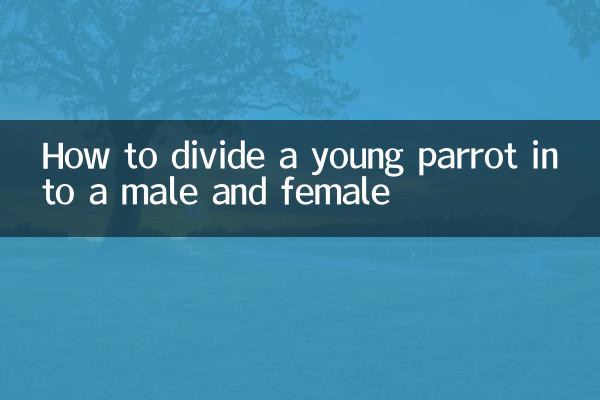How to divide a young parrot into a male and female
In the process of raising parrots, understanding the gender of the young parrots is very important for reproduction, pairing and daily management. However, the gender distinction between young parrots is not as obvious as that of adult parrots, and may be confusing for inexperienced novices. This article will combine popular topics and hot contents on the Internet for the past 10 days to introduce in detail the methods of distinguishing young parrots in gender, and provide structured data to help you easily identify the male and female of young parrots.
1. The importance of gender distinction between young parrots

Distinguishing the gender of young parrots not only helps scientifically feeding, but also avoids pairing failures or conflicts caused by gender unknown. For example, some parrot breeds have large differences in male and female personalities, and understanding the gender in advance can help the owner better plan the breeding environment.
2. Methods for distinguishing genders of young parrots
Here are several common ways to distinguish gender from young parrots:
| method | Suitable for parrot breeds | Accuracy | Operation difficulty |
|---|---|---|---|
| DNA detection | All varieties | More than 99% | Low (professional institution required) |
| Observe behavior | Some breeds (such as budgies) | 60%-70% | middle |
| Feather color | Some breeds (such as cockatiel) | 70%-80% | Low |
| Pelvic examination | Medium-large parrot | 80%-90% | High (experience required) |
1. DNA detection
DNA detection is currently the most accurate gender distinction method and is suitable for all parrot breeds. Simply collect blood, feathers or oral mucosa samples of the young parrot and send them to a professional institution to obtain the results. Although this method requires a certain cost, it has extremely high accuracy and is especially suitable for breeders with strict gender requirements.
2. Observe behavior
Some young birds in parrot breeds show gender differences in behavior. For example, male parrots may be more active and like to sing, while female parrots are relatively quiet. However, this method is greatly affected by individual differences and has limited accuracy.
3. Feather color
The feather color of young birds in some parrot breeds varies by gender. For example, cockatiel males usually have brighter head feathers, while females are lighter in color. This method requires some experience and not all varieties are suitable.
4. Pelvic examination
For medium and large parrots, gender can be distinguished by touching the pelvis. Female parrots are usually wider in pelvic spacing to facilitate egg laying. However, this method requires extensive experience. Improper operation may cause harm to young birds and is not recommended for beginners to try it.
3. Gender characteristics of different breeds of young parrots
Here are the gender characteristics of several common parrot breeds:
| variety | Male bird characteristics | Female bird characteristics |
|---|---|---|
| Budgerigar | The wax film is blue or purple | The wax film is white or brown |
| Cockatiel | Bright feathers on the head and orange-red cheeks | Lighter feathers on the head and lighter cheeks |
| Peony parrot | Larger, rounder head | Small size and pointed head |
4. Things to note
1.The gender characteristics of young birds are not obvious: The gender characteristics of young parrots usually appear gradually when they are 3-6 months old, so premature judgment may lead to errors.
2.Avoid frequent touch: The young birds are fragile and frequent touching or examination may cause stress or harm to them.
3.Combined with multiple methods: In order to improve accuracy, it is recommended to combine various methods to make judgments, especially for parrots for breeding purposes.
5. Summary
Distinguishing the gender of young parrots requires certain experience and skills, especially for novices. It is recommended to give priority to DNA testing or consult a professional veterinarian. Through the methods and structured data introduced in this article, we hope to help you better understand the gender distinction of young parrots and lay the foundation for scientific feeding and breeding.

check the details

check the details